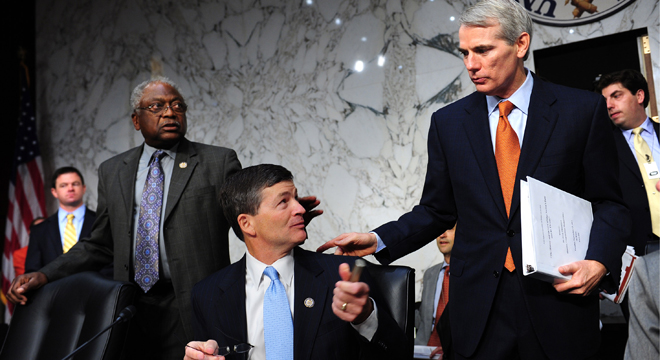A new Democratic memo rips apart a GOP Super Committee proposal — offered by Sen. Pat Toomey (R-PA) — that would have reduced, and made permanent, Bush-era tax rates. Many of the key details of the plan remain undisclosed, even to Democrats, but they’ve included a table laying out all of the lower rates the GOP has proposed, and deduced from what’s known that the changes would significantly reduce the progressiveness of the tax code.
Here’s how. The GOP claims the plan would raise $300 billion in revenue, and also make the newer, lower Bush tax rates permanent. To accomplish this, simple arithmetic implies he’d have to raise a ton of tax revenue elsewhere. But since he objects to raising taxes on capital income, that would require him to slash deeply into credits and preferences that benefit lower and middle income taxpayers.
Democrats drew a comparison to a similar plan — one with smaller tax cuts that has been scored by the Joint Committee on Taxation, and concluded:
The Toomey proposal either doesn’t provide any specifics about which tax expenditures he proposes to cut in order to raise $3.5 trillion — or the proposal simply doesn’t contain them. However, a similar proposal was recently scored by JCT that is almost as dramatic. It would make current policy permanent and then broaden the base sufficiently to pay for cutting all tax rates by roughly 15% from the 2011/12 rates (the top rate would be cut to 30%), with $600 billion left over. This proposal would cost almost as much – $3.0 trillion over ten years.
This similar proposal gives a sense of how dramatically Toomey’s proposal would have to cut deductions for the middle class. In order to raise $3.0 trillion, it would:
1. Reduce the personal and dependent exemptions ($3,800 per taxpayer and for each dependent) by 75%.
2. Reduce all itemized deductions, including the deductions for home mortgage interest, charitable contributions, and state and local taxes, by 75%.
3. Reduce certain above-the-line deductions by 75%.
4. Reduce all personal credits except the EITC, including the child tax credit, college tuition credits, and credits for retirement savings, by 75%.
Meeting Senator Toomey’s requirement of a top rate of 28% would require even more dramatic cuts to tax expenditures than those listed above. He has indicated that he is not open to raising taxes on capital income, including deductions for retirement savings and the reduced rates on capital gains and dividends, which generally benefit high-income taxpayers. This means that the only way to make the numbers add up is essentially to eliminate all of the deductions and credits listed above immediately with no transition, or to enact the tax expenditure cuts above and dramatically curtail the exclusion for employer-provided health insurance.
To simplify, the GOP proposes to slash benefits for low and middle income taxpayers to pay for a big tax cut that overwhelmingly benefits the rich.
When all’s said and done, this would raise most people’s overall tax burden, while increasing after-tax income for wealthy people. Here are charts laying out that impact for the analogous plan described above, which – again – contained less extensive rate cuts.


There are obviously a lot of caveats and unknowns here. But it’s no surprise Democrats rejected it.






